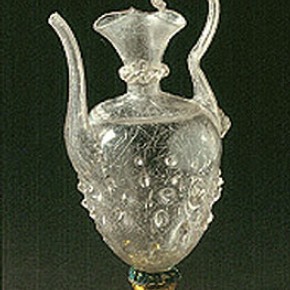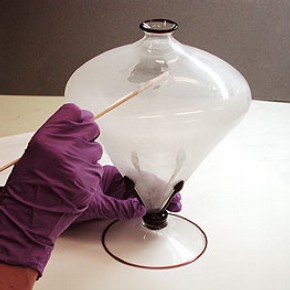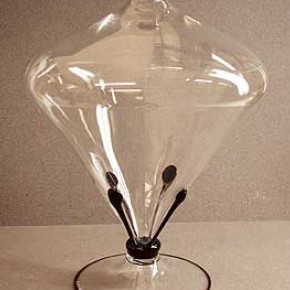Conservation Journal
Summer 2005 Issue 50
In pursuit of a clear answer: An Exhibition Road partnership

Figure 1: Glass ewer with gilt metal base (1809-1855), 17th century, Venetian or Netherlandish, in advanced state of decay (crizzled) (click image for larger version)
At the outset of the project in 1991, the team were under no illusion that finding a solution to the problem would be easy. Nor could it be foreseen that it would create such an enduring and productive partnership. It is through the perseverance and curiosity of its participants that at the end of the last phase of research in December 2004, the collaboration had been running successfully for thirteen years.
An article in this Journal's third issue1 recalls the then 'recent survey of the condition of 6500 objects at the V&A' which found that approximately 10% displayed some form of glass deterioration.2 Further surveys followed alongside the beginnings of research at ICSTM into the mechanisms of glass decay. The collaboration began modestly with a three month funded undergraduate project: Afi Amaku's quantitative chemical analysis of a 16th century Venetian glass. The supervisors, Dr Philip Rogers and Dr David McPhail (ICSTM) and Victoria Oakley (V&A), were sufficiently inspired by the results to seek funding for longer term post-graduate research.

Figure 2: Vase by Tapio Wirkkala, Finland 1950-1969 (Circ. 438-1964), with early signs of glass decay (cloudy appearance), during cleaning. Photography by Fi Jordan (click image for larger version)
The most recent phase of the research, funded by the Leverhulme Trust, enabled Dr Sarah Fearn, Research Associate, to take advantage of recent advances in analytical instrumentation to study the corrosion of glass samples at room temperatures. Consequently this approach gives a more accurate representation of museum conditions. Her research is discussed in the following article .
Over the years, the partnership has brought together not only scientists and conservators, but also curators and glassmakers. This has resulted in a balanced approach to the project. The scientist brings an analytical approach to complex scientific concepts, the curator provides a historical perspective and the craftsman reveals an insight into why an object was made in a certain way. The conservator can be seen to have a realistic approach to the treatment and display requirements of museum objects. They are also aware of the need to interpret results into workable, practicable procedures. As the affiliation grew over the years it is probably true to say that the team conspired to think alike. The shared goal has been the fundamental desire to find a practical solution to the problem whilst staying within acceptable ethical boundaries.
The researcher's role is pivotal in the team. Regular meetings kept all participants informed of their progress and also became a forum for constructive criticism and an exchange of ideas. The researcher was encouraged to disseminate information in journals and conference papers and to develop links with other institutions and interested parties. This has contributed to a greater understanding of glass deterioration amongst a wider community.
Each research project has built on the findings of the previous studies, often generating more questions than answers, and emphasising the importance of further investigations. There is, therefore, a clear need to continue the work that has been completed so far. This will require a further commitment of resources from interested parties. In the article that follows, Sarah Fearn ends by highlighting a number of areas she feels require further research. Most importantly, they emphasise the need to focus investigations on practical proposals that will bring us closer to finding clear guidance on the optimum environmental conditions and interventive treatments required in the care of vulnerable glass objects.
References
1. Oakley, V., Rogers, P., McPhail, D., Amaku, A., Vessel Glass Deterioration in the Museum Environment: a Quantitative Study by Surface Analysis, 'V&A Conservation Journal' No 3 (1992)
2. Oakley, V., Vessel glass deterioration at the Victoria and Albert Museum: surveying the collection, 'The Conservator', 14 (1990), pp.30-36
3. Ryan, J., 'The Atmospheric Deterioration of Glass: Studies of Decay Mechanisms and Conservation Techniques', PhD Thesis, University of London (1996)
Summer 2005 Issue 50
- Editorial
- Rising damp - a history of the Conservation Department
- V&A Conservation on the world wide web: a secondment to the V&A web team
- The ethics checklist - ten years on
- Plastics preservation at the V&A
- Working for Diaghilev
- Pugin's wallpapers from The Grange
- Prevention is better than the cure
- Research
- The Castellani diadem
- In pursuit of a clear answer: An Exhibition Road partnership
- Investigation of the room temperature corrosion of replica museum glass
- Professional collaboration - the Prince of Wales Museum of Western India
- V&A/RIBA partnership
- Picture and mirror frames: Reflections on treatment past, present and future
- A simple solution?
- Appendix 1: Victoria & Albert Museum Conservation Department Ethics Checklist
- Conservation of a tortoiseshell book cover
- The hand that rocks the cradle: Conservation administration, present and future
- Printer friendly version
